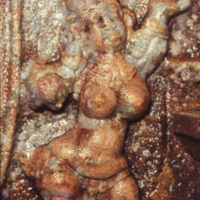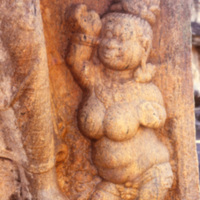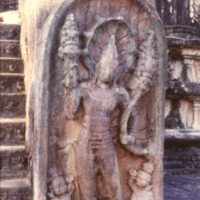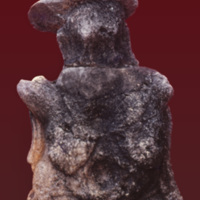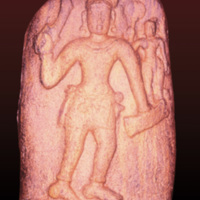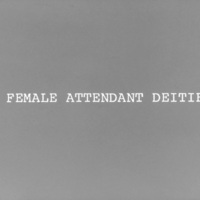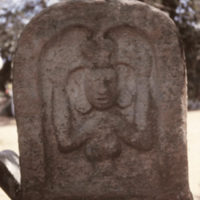Main Menu
AORC Libraries
Browse Archive Items (14 total)
A nāgini, female cobra of dwarfish stature
Description: Belonging to about the 12th century A.D. is this female bahirava, bearing a chamara. She attends on the nagi guardian on the balustrade of the Lankatilaka Vihare at Polonnaruva, Sri Lanka.
Contributor: Co-Author: Seneviratna, Harsha
Collection: Women in Sri Lankan Sculpture and Painting
Tags: AISLS, Attendant Goddesses, ICES, PDWESLSP
A nāgini, female cobra of dwarfish stature
Description: This female bahirava, with a cobra twirling round her hair-do, is a naga attendant of the nagaraja carved on a guardstone at the Vatadage in Polonnaruva, Sri Lanka. A date between the 10th and 12th centuries A.D. may be suggested for this sculpture.
Contributor: Co-Author: Seneviratna, Harsha
Collection: Women in Sri Lankan Sculpture and Painting
Tags: AISLS, Attendant Goddesses, ICES, PDWESLSP
A nāgini, female cobra of dwarfish stature
Description: This female bahirava, with a cobra twirling round her hair-do, is a naga attendant of the nagaraja carved on a guardstone at the Vatadage in Polonnaruva, Sri Lanka. A date between the 10th and 12th centuries A.D. may be suggested for this sculpture.
Contributor: Co-Author: Seneviratna, Harsha
Collection: Women in Sri Lankan Sculpture and Painting
Tags: AISLS, Attendant Goddesses, ICES, PDWESLSP
Bahiravi, mythical female
Description: The bahiravas in Sri Lankan art are mythical in character, dwarfish in size and grotesque in appearance. A unique example of a bahirava, this stone figure, which appears to be in a kneeling posture, is placed in the compound of the Vave devalaya at Minneriya, Sri Lanka. It was originally associated with images of other male and female goddesses which are now housed in the inner sanctuary of the develaya. Her dress and ornaments suggest a date in the 3rd or 4th century A.D.
Contributor: Co-Author: Seneviratna, Harsha
Collection: Women in Sri Lankan Sculpture and Painting
Tags: AISLS, Attendant Goddesses, ICES, PDWESLSP
Female attendant
Description: Placed in a palace context, this life-size sculpture of a chamara bearer of the 18th century. It is one of four brick and stucco reliefs carved on the walls of the entrance hall at the royal palace in Kandy, Sri Lanka. They may represent a realistic picture of the type of attendant of royalty during this time, or they may even represent apsaras, for divine status was an attribute of kingship.
Contributor: Co-Author: Seneviratna, Harsha
Collection: Women in Sri Lankan Sculpture and Painting
Tags: AISLS, Attendant Goddesses, ICES, PDWESLSP
Divine maiden (apsara)
Description: At the Archaeological Museum, Anuradhapura, Sri Lanka is this hero stone from Polonnaruva. Here the hero appears in the divine world attended by a female bearing a fan.
Contributor: Co-Author: Seneviratna, Harsha
Collection: Women in Sri Lankan Sculpture and Painting
Tags: AISLS, Attendant Goddesses, ICES, PDWESLSP
Divine maidens (apsaras)
Description: This is the upper section of a hero-stone where an image in the mind’s eye of the hero is shown flanked by two divine maidens or apsaras with chamaras. Ascribed to a period between the 10th and 12th centuries, this relief sculpture, seen at the Archaeological Museum in Anuradhapura, was originally found at a place known as Velanadamana, in the Vilacchi Korale of the North Central Province, Sri Lanka.
Contributor: Co-Author: Seneviratna, Harsha
Collection: Women in Sri Lankan Sculpture and Painting
Tags: AISLS, Attendant Goddesses, ICES, PDWESLSP
Attendant goddesses
Description: Attendant goddesses, both male and female, occupying subordinate positions are a familiar occurrence in early Sri Lankan sculpture. Divine maidens bearing chamaras or fly whisks and sometimes fans, as well as female dwarfs fall into this category.
Contributor: Co-Author: Seneviratna, Harsha
Collection: Women in Sri Lankan Sculpture and Painting
Tags: AISLS, Attendant Goddesses, ICES, PDWESLSP
Earth goddess
Description: This painting represents the polovamahikanthava, or earth goddess, rising out of the earth as witness to the Buddha's former deeds. The personification of the earth as goddess in temple art is a popular device in the Kandyan period (16th-18th century A.D.). This painting from Degaldoruva, Kandy, Sri Lanka, is a symbolic expression of the earth rising up to bear witness to the Buddha’s deeds in earlier times.
Contributor: Co-Author: Seneviratna, Harsha
Collection: Women in Sri Lankan Sculpture and Painting
Tags: AISLS, Attendant Goddesses, ICES, PDWESLSP
Earth goddesses
Description: These two female busts are identified as the earth goddesses or polovamahikanthava who acts as guardians. They seem to rise out of the earth from their placement at the entrance to a Buddhist temple. This guardstone, is one of two found at the entrance to the precincts of the Dippitiya Vihare in the Kegalle district, Sri Lanka. The temple is dated in the Kandyan period (16th-18th century A.D.).
Contributor: Co-Author: Seneviratna, Harsha
Collection: Women in Sri Lankan Sculpture and Painting
Tags: AISLS, Attendant Goddesses, ICES, PDWESLSP



